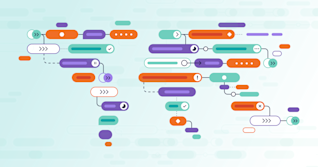The last few years have seen an explosion in artificial intelligence, machine learning, and other types of projects. Companies like Hugging Face and applications like DALL-E 2 have brought to the mainstream what the power of AI/ML can bring to the next generation of computing and software. As every company has become a software company over the last few decades, the ability to innovate and leverage the ever-growing amount of data that organizations have access to have become where enterprises turn to compete.
However, a lot of AI/ML projects get stalled from several challenges that may seem familiar to software professionals who have been around since the early days of DevOps. Adoption and optimization of artificial intelligence and machine learning have been hampered by a lack of repeatability for experiments, a disparity of tools and information silos, and a lack of team collaboration.
A new model for data modeling
One of the first ways to look at this problem is to make sure that the mental model is in place to allow the team to reason about both the strategic vision for AI/ML at your organization. And once that has been established, also think about the tactical “jobs to be done” to lay the foundation for that work.
Strategically, there are many teams that have to come together for a successful AI/ML program. First, the data has to both be acquired and transformed into a usable set of clean data. Often referred to as “DataOps” this involves the typical “ETL” or extract, load, transform processes data has to go through to be useful for teams. From there, you have to productionize the data workloads through MLOps - the experimentation, training, testing, and deployment of meaningful models based on the extracted and transformed data.
And once those two steps are complete, you can finally understand how to make production use cases for your data. You can use AI Assisted features to focus on improving user experiences, for financial forecasting, or for general trends and analysis of various parts of your business. Given the complexity of this value chain, the various teams and skills involved, and the current mishmash of tooling, there is a lot that teams can learn from the history of DevOps as they tackle these problems.
DevOps and AI/ML
Much like the various stages of obtaining and applying AI/ML for business uses, software development consists of many varied steps with different teams and skills sets to achieve the business goals outlined. That is why years ago, folks came up with this concept of “DevOps”– combining teams and having them work together in a cycle of continuous improvement towards the same goals – to combat silos and inefficiencies.
Data science teams are using specialized tools that don't integrate with the existing software development lifecycle tools they already use. This causes teams to work in silos, creating handoff friction and resulting in finger-pointing and lack of predictability. Businesses and software teams often fail to take advantage of data, and it takes months for models to get into production by which time they may be out of date or behind competitors. Security and data ethics are frequently treated as an afterthought. This creates risk for organizations and slows innovation.
Learning from the past
If the past decades of “DevOps” evolution have taught us anything, it's that breaking down the silos between teams through the tools and processes they are using pays off dividends for business. As your team begins their AI/ML journey — or if you've found yourself stalling in AI/ML initiatives already — you should consider how you can consolidate teams together, ensure they are working efficiently together, and able to collaborate without boundaries.
An explosion of tools in the space is tantalizing with the promise of “getting started” quickly. But it may not set your organization up for long-term success in these areas if those tools have the effect of separating parts of your organization from one another. Creating and sustaining an AI/ML program will require intentionality behind both the processes and tools your team is using. That allows your teams to extract, transform and load data efficiently, tune, test and deploy models effectively, and leverage AI/ML to drive value for your stakeholders for the long haul.



